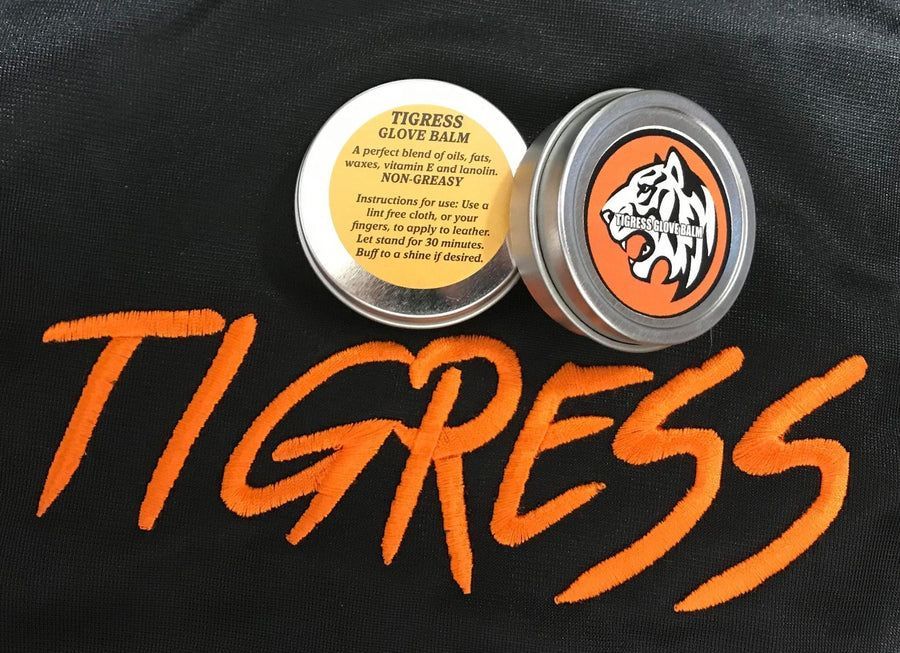WHAT IS THE BEST WAY TO BREAK IN SOFTBALL GLOVES?
Here at Tigress Gloves, we believe that breaking in your softball gloves is essential for their longevity and for making them easy for the player to use. Our softball gloves will remain in pristine condition for many years when you follow our recommendations and conduct proper care and storage.
The Best Way to Break in Softball Gloves
Given the widespread adoration for softball across the country, it's no surprise that the care practices for softball gloves vary from region to region. When breaking in new gloves, some individuals resort to unconventional methods like oil or shaving cream to prepare the leather for gameplay. However, we aren't fans of making softball gloves heavier or greasier merely to expedite the breaking-in process.
We take a different route in our meticulous approach to crafting Tigress gloves and preparing them for shipment. Instead of resorting to substances that might alter the glove's weight or texture, we opt for a more controlled technique. As part of our preparation, we tightly wrap the glove with a bandage, securing it with a ball inside. This method ensures that the softball glove's hinge point remains flexible at the bottom. The objective is to prevent stiffness, especially after prolonged periods of non-use, such as overnight storage.
This principle holds for our Tigress gloves and other high-quality gloves available on the market. While providing durability, the exceptional leather used in high-quality gloves often starts in a stiffer state. Manufacturers intentionally ship stock gloves in this condition, avoiding premature softening during transit. Once the glove fibers have undergone initial manipulation, it becomes challenging to restore their original stiffness.
As manufacturers committed to delivering top-notch stock softball gloves, we acknowledge that the stiffness inherent in new gloves is by design. Our dedication lies in ensuring our gloves' longevity and peak performance, recognizing that the initial stiffness is a characteristic of high-quality craftsmanship. So, while unconventional methods may exist, our approach emphasizes precision and preservation, guaranteeing that your investment in a Tigress Gloves glove is well worth it from the very first game.
Mastering the art of breaking in your newly acquired high-quality softball glove demands a combination of thoughtfulness and patience. Rather than hastily navigating this crucial process, invest time meticulously following the steps outlined below, and you'll witness a remarkable transformation in your glove's flexibility and comfort.
Watch our “Break in Your Glove” video about our recommendation on how to break in your glove. You can view our other videos on our YouTube channel.
1. Stretch the Lacing:
Embark on the breaking-in journey by delicately pulling on the laces at the top of your glove, ensuring an even spread with both hands. This initial, gentle manipulation lays the groundwork for the glove's ultimate flexibility, a vital factor in optimizing its performance.
2. Utilize a Hitting Mat:
For the subsequent steps, consider employing a hitting mat at home, which provides an ideal surface for breaking in your glove. Without such a mat, procure a comparably padded surface from online platforms. The objective is to create a cushioned yet firm area that minimizes discomfort during the breaking-in process. Steering clear of hitting the glove on your lap is essential to preventing accidental injuries.
3. Webbing Stretch:
After loosening the webbing, execute firm strikes to the web, ensuring it stays positioned away from the leather. This practice guarantees that the webbing remains unobtrusive during play, facilitating smoother usage of the softball glove. Embrace the natural stretching of the webbing as an inherent part of breaking in a new glove.
4. Focus on the Glove Center:
While addressing the webbing, it is crucial to pay attention to the center of the glove to solidify its position. For infielder gloves (approximately 11.5 inches), concentrate on closing from thumb to middle finger, while outfielders target closure from thumb to pinky. Although strikes to the center contribute less to the breaking-in process, they play a vital role in establishing the desired shape.
5. Gradual Movement:
Introduce gradual movements to all glove parts during the breaking-in process, ensuring uniform flexibility. This allows players to refine their preferences for glove closing as they familiarize themselves with its feel during actual gameplay.
6. Heel Strikes:
Secure the glove, roll it slightly, and deliver firm strikes to the heel to expedite the softening process. Repeating this process will increase softness, allowing the glove to close more effortlessly. The substantial change in the glove's feel becomes evident after the initial breaking-in session.
7. Proper Storage:
Ensuring proper storage is equally critical to maintaining the glove's open shape. Always place a ball inside before stowing it in your backpack, preventing the dreaded "taco glove" effect. If the glove loses its form, professional repair or replacement may become necessary.
https://www.tigressgloves.com/product/POCKET-SAVER
By meticulously adhering to these steps and affording your softball glove the attention it deserves, you pave the way for a quicker and more effective breaking-in process, ultimately leading to enhanced performance on the field.
What Are the Different Ways to Store Softball Gloves?
Designated Storage Area
Creating a specific storage area for your softball equipment is foundational to maintaining order and accessibility. Whether it's a dedicated section in your garage, a sports equipment rack, or a well-organized sports bag, having a designated spot ensures each piece of equipment has a home. This minimizes the chances of misplacing items and streamlines the process of gearing up for practices and games.
Hang Gloves on Hooks
Installing hooks on a wall or within your designated storage space provides an efficient solution for keeping your softball gloves in optimal condition. Hanging gloves prevent them from being crushed or misshapen, preserving their integrity over time. Additionally, this setup facilitates easy access, allowing you to effortlessly grab the right glove when needed, ensuring you're always game-ready.
Cubbies or Shelves
Utilize cubbies or shelves within your storage area to meticulously organize smaller items like softballs, batting gloves, and helmets. Labeling each cubby or shelf adds a touch of systematic order and accelerates identifying and accessing the necessary equipment. This approach contributes to an overall clutter-free and efficient storage solution.
Separate Bat Compartment
Consider having a designated compartment for your bats for an added layer of organization. This prevents them from colliding with each other, minimizing the risk of scratches or damage. A separate bat compartment also simplifies selecting the right bat for each game, ensuring you're well-equipped for success.
Mesh Bags for Balls
Investing in mesh bags for storing softballs serves a dual purpose. It keeps the softballs neatly together, and the mesh material also allows for proper ventilation. This helps prevent unpleasant odors from lingering in the bag, ensuring your equipment remains fresh and game-ready. If you would like to keep your glove separate from the softballs, you can stick with a simple Tigress Glove bag.
https://www.tigressgloves.com/product/TIGRESS-GLOVE-BAG
Equipment Bins
Leverage large plastic bins to corral miscellaneous items such as first aid kits, spare cleats, or practice jerseys. Clearly labeling each bin enhances visibility and ease of identification. This approach contributes to an organized and easily maintainable storage system for your softball gear.
Travel Bag Organization
For those with a dedicated softball travel bag, maximize its potential by strategically utilizing its various compartments. Assign specific sections for gloves, balls, cleats, and personal items. This thoughtful organization ensures that everything has its designated place and streamlines the packing and unpacking process, making your pre-game routines more efficient.
Helmet Hooks
Install hooks designed explicitly for helmets within your storage area. This precaution prevents helmets from getting scratched or damaged, ensuring they remain pristine. Easily accessible helmets contribute to a seamless gearing-up process, promoting a hassle-free transition to the field.
Cleat Racks
Consider installing a cleat rack or using shoe organizers to keep cleats in order. This prevents dirt and mud from spreading and simplifies locating the right pair for each game. Organized cleats contribute to an overall polished and prepared appearance on the field.
Equipment Checklist
Developing a comprehensive checklist for all your softball gear is an essential practice. Regularly reviewing the list ensures that each item is in its designated place, providing a quick and efficient way to track any missing gear. This proactive approach guarantees you're consistently prepared for practices or games, reducing the likelihood of overlooking crucial equipment.
Helmet Shelf or Cubby
Extend your organizational prowess by dedicating a shelf or cubby specifically for helmets. This ensures that each helmet has its own designated space, preventing them from becoming entangled or knocked about in the storage area. Having a clearly defined spot for helmets enhances their longevity and simplifies locating the right one for each game.
Bat Weight and Grip Bin
For those who use different bat weights or grips, consider having a separate bin designated for these accessories. This maintains a tidy storage space and ensures that you can quickly access the right weight or grip adjustment before stepping up to the plate.
Drying Rack for Wet Gear
Incorporate a drying rack into your storage area, especially if you play in damp conditions. This designated space allows wet gear, such as gloves or jerseys, to air out properly, preventing the development of unpleasant odors and ensuring your equipment stays in prime condition.
Personalized Gear Tags
Enhance your organization further by adding personalized gear tags to each piece of equipment. These tags can include your name, team logo, or any other identifying information. This adds a personal touch and makes it easy to identify and retrieve your gear when sharing a storage space with teammates.
Spare Parts Bin
Create a bin specifically for spare parts such as laces, straps, or screws. This ensures that you always have essential components for quick repairs or adjustments, preventing any last-minute equipment issues from affecting your game.
Other Articles

Subscribe to our
Newsletter
Our newsletter is focused on bringing you the latest in news & tips.
Join the Newsletter
Thank you for subscribing.
Please try again later
All Rights Reserved | Tigress Gloves
Website by SPECK DESIGNS
All Rights Reserved | Tigress Gloves
Website by SPECK DESIGNS





